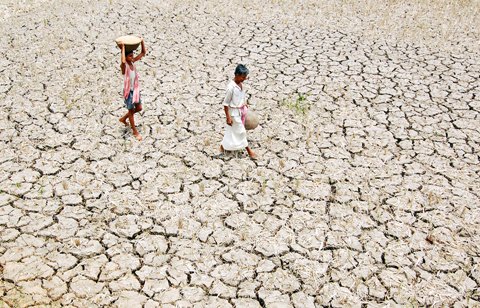Crops are shriveling as India faces the specter of drought, but economists say they are still upbeat about the country’s economic prospects.
They are banking that a strong industrial performance will help offset the impact of the worst monsoon in years in Asia’s third-largest economy.
Analysts have been buoyed by new data showing industrial production jumped by 7.8 percent in June from a year earlier — its quickest pace in 16 months.

PHOTO: AFP
Output was spurred by record low interest rates and government stimulus that have prompted consumers to purchase factory-made products such as cars and refrigerators.
The figures last week came on top of a slew of other economic indicators suggesting India is starting to rebound from the impact of the worst global downturn since the 1930s.
“The domestic economy is slowly but definitely reviving,” said Deepak Lalwani, India director at investment house Astaire & Partners in London.
Even with “the rain gods playing hooky,” a robust industry and service sector outlook “should offset the [economic] hit from agriculture,” said Rajeev Malik, economist at Macquarie Securities.
Malik said he was sticking to his forecast of 7 percent growth for the current fiscal year to March, although he said “a bigger hit to agriculture might warrant a downward revision.”
India’s economy expanded by 6.7 percent last year after growing by a scorching 9 percent for several years in a row.
HSBC economist Robert Prior-Wandesforde, who expects 6.2 percent growth, said the June industrial output number “suggests there is plenty of momentum” outside the agricultural sector.
He said there was “plenty more in the way of positive effects” to come from the central bank’s aggressive interest rate cuts and government stimulus.
“The upside from industrial activity [is] likely to mitigate the negative impact of poor rains,” Goldman Sachs analysts Tushar Poddar and Pranjul Bhandari wrote in a note to clients.
Economists’ optimism about overall prospects stems partly from the reduced role that agriculture now plays in India’s economy — accounting for around 17 percent of GDP, down from 50 percent in the 1950s.
For India’s 235 million farmers, many of them smallholders eking out a living, a single bad monsoon can spell financial disaster, wiping out livelihoods.
India’s official weather map is a mass of red — the color the weather office uses to show “deficient” rains, defined as 20 percent to 59 percent below normal.
Some 177 out of India’s 626 districts are in the grip of drought, with rice crops the worst hit. Only a thin strip along the western coast has received normal rain during this monsoon season, which runs from June to September.

CHIP WAR: Tariffs on Taiwanese chips would prompt companies to move their factories, but not necessarily to the US, unleashing a ‘global cross-sector tariff war’ US President Donald Trump would “shoot himself in the foot” if he follows through on his recent pledge to impose higher tariffs on Taiwanese and other foreign semiconductors entering the US, analysts said. Trump’s plans to raise tariffs on chips manufactured in Taiwan to as high as 100 percent would backfire, macroeconomist Henry Wu (吳嘉隆) said. He would “shoot himself in the foot,” Wu said on Saturday, as such economic measures would lead Taiwanese chip suppliers to pass on additional costs to their US clients and consumers, and ultimately cause another wave of inflation. Trump has claimed that Taiwan took up to

A start-up in Mexico is trying to help get a handle on one coastal city’s plastic waste problem by converting it into gasoline, diesel and other fuels. With less than 10 percent of the world’s plastics being recycled, Petgas’ idea is that rather than letting discarded plastic become waste, it can become productive again as fuel. Petgas developed a machine in the port city of Boca del Rio that uses pyrolysis, a thermodynamic process that heats plastics in the absence of oxygen, breaking it down to produce gasoline, diesel, kerosene, paraffin and coke. Petgas chief technology officer Carlos Parraguirre Diaz said that in

SUPPORT: The government said it would help firms deal with supply disruptions, after Trump signed orders imposing tariffs of 25 percent on imports from Canada and Mexico The government pledged to help companies with operations in Mexico, such as iPhone assembler Hon Hai Precision Industry Co (鴻海精密), also known as Foxconn Technology Group (富士康科技集團), shift production lines and investment if needed to deal with higher US tariffs. The Ministry of Economic Affairs yesterday announced measures to help local firms cope with the US tariff increases on Canada, Mexico, China and other potential areas. The ministry said that it would establish an investment and trade service center in the US to help Taiwanese firms assess the investment environment in different US states, plan supply chain relocation strategies and

Japan intends to closely monitor the impact on its currency of US President Donald Trump’s new tariffs and is worried about the international fallout from the trade imposts, Japanese Minister of Finance Katsunobu Kato said. “We need to carefully see how the exchange rate and other factors will be affected and what form US monetary policy will take in the future,” Kato said yesterday in an interview with Fuji Television. Japan is very concerned about how the tariffs might impact the global economy, he added. Kato spoke as nations and firms brace for potential repercussions after Trump unleashed the first salvo of